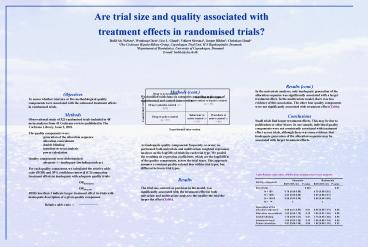Methods cont' PowerPoint PPT Presentation
1 / 1
Title: Methods cont'
1
Are trial size and quality associated with
treatment effects in randomised trials?
Bodil Als-Nielsena, Wendong Chena, Lise L.
Gluuda, Volkert Siersmab, Jørgen Hildenb,
Christian Gluuda aThe Cochrane Hepato-Biliary
Group, Copenhagen Trial Unit, HS Rigshospitalet,
Denmark bDepartment of Biostatistics, University
of Copenhagen, Denmark E-mail bodil.a_at_ctu.rh.dk
Results (cont.) In the univariate analyses, only
inadequate generation of the allocation sequence
was significantly associated with a larger
treatment effect. In the multivariate model,
there was less evidence of this association. The
other four quality components were not
significantly associated with treatment effect
(Table). Conclusions Small trials find larger
treatment effects. This may be due to publication
or other biases. In our sample, individual
quality components were not consistently
associated with treatment effect across trials,
although there was some evidence that inadequate
generation of the allocation sequence may be
associated with larger treatment
effects.
Methods (cont.) We classified trials into six
categories according to the type of experimental
and control intervention As inadequate
quality components frequently co-occur, we
performed both univariate and multivariate
weighted regression analyses on the log(OR) of
trials for each trial type. We pooled the
resulting six regression coefficients, which are
the log(ROR)s of the quality components, across
the trial types. This approach assumes a constant
quality-related bias within trial types, but
different between trial types. Results The
trial size, entered as precision in the model,
was significantly associated with the treatment
effect in both univariate and multivariate
analyses the smaller the trial the larger the
effect (Table).
Objectives To assess whether trial size or five
methodological quality components were associated
with the estimated treatment effects in
randomised trials. Methods Observational study
of 523 randomised trials included in 48
meta-analyses from 41 Cochrane reviews published
in The Cochrane Library, Issue 2, 2001. The
quality components were generation of the
allocation sequence allocation
concealment double blinding intention-to-treat
analysis power calculation Quality components
were dichotomized adequate ltgt inadequate
(including unclear) For each quality component,
we calculated the relative odds ratio (ROR) and
95 confidence interval (CI) comparing treatment
effects in inadequate with adequate quality
trials ORinadequate ORadequate
RORs less than 1 indicate larger treatment
effect in trials with inadequate description of a
given quality component.
Control intervention
Experimental intervention
Relative odds ratio

